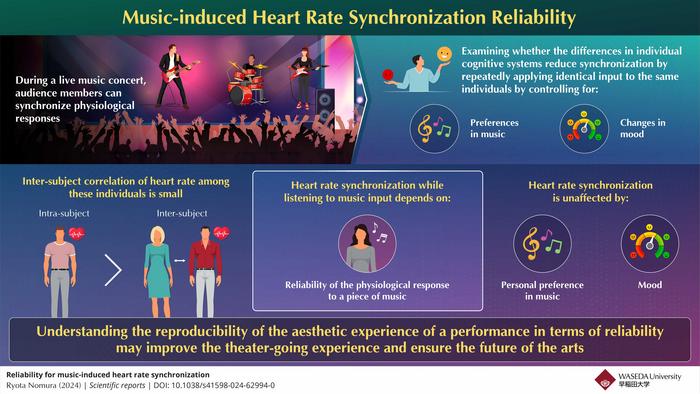Common input synchronization is a process where systems or organisms exposed to an identical input respond similarly. People listening to a concert, for example, could experience a synchronization of their emotions. “Music-induced synchronization of heart rate may be the mechanism underlying the coherent behavior of a large audience in a theater,” suggests Ryota Nomura, an Associate Professor affiliated with Waseda University, Japan, while describing the mechanism. Previous studies have shown that inter-subject correlations calculated using physiological signals, including heart rate, are usually low. Studies investigating the common-input induced synchronization in different individuals suggest that the low correlation is due to weak intra-person correlation between the conscious processing and heart rate. This intra-person correlation is challenging to control directly. Hence, the current study by Dr. Nomura eliminated the individual differences in the processing by applying common input to the same individuals repeatedly.

Credit: Ryota Nomura of Waseda University
Common input synchronization is a process where systems or organisms exposed to an identical input respond similarly. People listening to a concert, for example, could experience a synchronization of their emotions. “Music-induced synchronization of heart rate may be the mechanism underlying the coherent behavior of a large audience in a theater,” suggests Ryota Nomura, an Associate Professor affiliated with Waseda University, Japan, while describing the mechanism. Previous studies have shown that inter-subject correlations calculated using physiological signals, including heart rate, are usually low. Studies investigating the common-input induced synchronization in different individuals suggest that the low correlation is due to weak intra-person correlation between the conscious processing and heart rate. This intra-person correlation is challenging to control directly. Hence, the current study by Dr. Nomura eliminated the individual differences in the processing by applying common input to the same individuals repeatedly.
Dr. Nomura has recently published this insightful study in Scientific Reports on 28 May 2024. In the study, Dr. Nomura showed that the synchronization of physical and cognitive processes is better within an individual compared to that between different individuals. The study revealed that the heart rate synchronization in response to music depends on the reliable physiological responses of the listener, not on their mood or music preferences. “This study allows us to explain the reproducibility of the aesthetic experience of the theater in terms of reliability,” notes Dr. Nomura.
The study investigated the inter- and intra-subject correlations calculated using instantaneous heart rate data measured while listening to music. To estimate the effect of mood on music-induced heart rate synchronization, Dr. Nomura had participants in the study listen to the same piece of music on different days. Likewise, to quantify the influence of music preference on heart rate synchronization, he investigated whether a person listening to a piece of music selected by the researcher differed in synchronization response to a piece of music that deeply moves them when played in a randomized order.
Dr. Nomura discovered that the reliability with which a subject’s heart rate responded to the music is significantly more correlated across time for a given individual, compared to the inter-subjective correlation in responses between individuals.
“The results demonstrated that inter-subject correlations were consistently lower compared to intra-subject correlations, regardless of participants’ music preferences and daily moods. Further, music-induced heart rate synchronization depends on the reliability of physiological responses to musical pieces rather than mood or motivation,” Dr. Nomura observes.
Overall, the study will lead to a greater understanding of collective human emotion as a way to improve the theater-going experience. By discovering what factors contribute to heart-rate synchronization and consequent emotional response, this study offers valuable clues for the success of performing arts. “From data on small audiences, for example, the degree of proficiency of performers, commercial success can be predicted in terms of reliability. This could contribute to better performances in theaters. Moreover, engineered devices that enhance reliability may facilitate synchronization of the physiological states of multiple audience members,” concludes Dr. Nomura, while highlighting the implications of the study.
***
Reference
Authors: Ryota Nomura
Affiliations: Faculty of Human Sciences, Waseda University, Japan
About Waseda University
Located in the heart of Tokyo, Waseda University is a leading private research university that has long been dedicated to academic excellence, innovative research, and civic engagement at both the local and global levels since 1882. The University has produced many changemakers in its history, including nine prime ministers and many leaders in business, science and technology, literature, sports, and film. Waseda has strong collaborations with overseas research institutions and is committed to advancing cutting-edge research and developing leaders who can contribute to the resolution of complex, global social issues. The University has set a target of achieving a zero-carbon campus by 2032, in line with the Sustainable Development Goals (SDGs) adopted by the United Nations in 2015.
To learn more about Waseda University, visit
About Associate Professor Ryota Nomura
Dr. Ryota Nomura has been an Associate Professor at the School of Human Sciences at Waseda University, Japan, since 2020. Dr. Nomura is a cognitive scientist who received his Ph.D. in Psychology from Kyushu University in 2008 and Ph.D. in Engineering from Tokyo University of Science in 2016. He has over eight years of research experience and has published over 26 research articles in areas involving engineering in education, human blinking behavior, proficiency of stage actors, etc. Dr. Nomura has previously worked in various research and teaching roles at Kagoshima Immaculate Heart University, The University of Tokyo, and Kyushu University. Dr. Nomura has also been awarded the Best Paper Award by the Japanese Cognitive Science Society for his paper on cognitive studies in 2015.
Journal
Scientific Reports
Method of Research
Experimental study
Subject of Research
People
Article Title
Reliability for music‑induced heart rate synchronization
Article Publication Date
28-May-2024
COI Statement
The author declares no competing interests.



